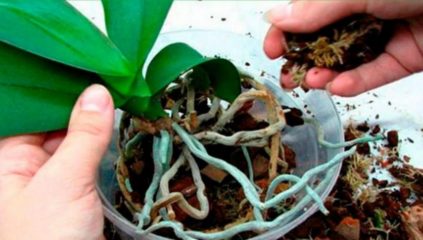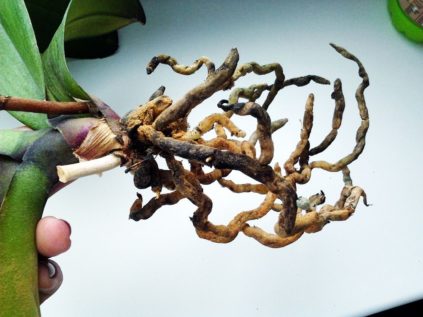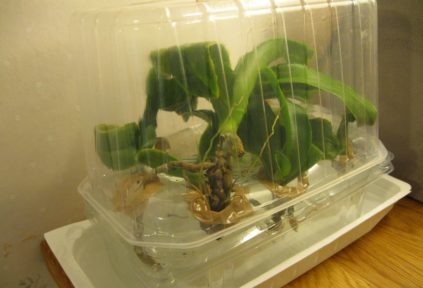How to root a flower: ways to build up the underground part
There are several ways to revive the phalaenopsis left without roots and grow new roots. The method is chosen depending on the condition of the flower and the availability of the necessary materials. Rooting is a long process, it will take at least three to four weeks, and if the instructions are not fully followed, it can take up to a year.
How to grow roots in a greenhouse?
A mini-greenhouse for rooting an orchid is built from scrap materials. There are two main ways to create a greenhouse effect:
- The container with the orchid is placed in a plastic bag and tightly closed.
- The container with the plant is covered with a glass or plastic cap. You can use a cut water bottle, plastic containers, glass jars, and so on.
In both cases, the orchid is prepared for planting as follows:
A container is selected in which the roots that remain after pruning can freely fit.
Drainage material is prepared: expanded clay and sphagnum moss.
All materials, including moss, must be disinfected with boiling water.
An orchid without roots is weakened and a possible infection will prevent it from taking root.
Expanded clay is spread on the bottom of the prepared container, wet sphagnum moss is placed on top.
The orchid is placed on the moss, the remaining roots are also covered with moss.
The finished container with the orchid is placed in a bag or covered with a cap.
If a plastic bag is used, it is important that there is air in it. You can close the bag with clothespins.
A greenhouse with an orchid is placed in a well-lit place. The temperature is kept from +22 to +25 degrees. Phalaenopsis in the greenhouse is checked and ventilated once a day so that mold does not form or re-decay does not begin. It is better to air it in the evening, for 15-20 minutes.
This video shows how to grow roots in a greenhouse:
In water
Phalaenopsis can grow roots if placed in a container of water. At the same time, drying will be needed every day. Without it, surviving plants will not adapt well to the soil in the future and will be very sensitive to watering.
- To root phalaenopsis, take warm water, settled or passed through a filter.
- The flower is placed every day in a disinfected container with prepared water to a depth of two centimeters so that the water does not touch the leaves.
- The plant is kept in water for no more than 6-7 hours, then the root system is dried in the open air.
Attention! The method of resuscitating an orchid in water with regular drying is good in that it minimizes the risk of diseases (bacterial or fungal) during the rooting process.
Above the water
This method is convenient in that it requires a minimum of manipulations with the plant in the process of root growth. You will need a narrow container for an orchid and filtered or boiled water at room temperature.
- The prepared vessel is disinfected, then boiled water is poured into it and the phalaenopsis is fixed so that its lower part is 1-2 centimeters above the water surface. It is best to use a narrow and high container.
- The container with the plant is placed in a well-lit place with diffused light. Suitable temperature is from +23 to +25 degrees.
How else to stimulate growth?
Sometimes phalaenopsis can be rooted by placing it on a large piece of bark soaked in water. In this case, the plant does not need to be additionally watered, but the bark is replaced or re-soaked every one and a half to two months. This method is rarely used, as it is longer than the others and less effective.
What to do to save the plant at home, if all the roots are rotten, but sluggish leaves remain?
What if you flooded the plant and did not notice that the roots began to rot, but they completely rotted, and only the outlet remained? In this case, before planting in the substrate, it is necessary to provide the orchid with special conditions so that it can restore the root system at least partially. Otherwise, the plant's chances of survival are minimal. Without roots, soil fungi will begin to infect the stem and leaves (why does an orchid leaf rot?). Several methods are used for germination, the choice depends on the state of the indoor flower.
In the greenhouse
To restore orchids that have completely rotted roots, a window greenhouse is used. You can make it yourself. It is necessary to make a frame in the form of a deep box and cover it with polyethylene on five sides. The bottom is left open.
When it is necessary to care for a sick orchid, the box is raised, therapeutic measures are carried out and put back.
For small specimens, you can create a greenhouse from any transparent container:
- a plastic bottle;
- cake lids;
- glass jars.
Creating a greenhouse effect greatly increases the plant's chances of survival. Warm humid air stimulates root formation, but prevents moisture from accumulating in the velamen.
A sick orchid is planted in a special container filled with expanded clay 2-3 cm, sprinkled with moss on top. The substrate is periodically sprayed from a spray bottle. To increase humidity, you can put a container of water next to the affected plant. The orchid is kept in a greenhouse until 4-5 cm roots appear, usually 2-3 weeks.
The greenhouse method gives the best results in the restoration of the root system.
Without a greenhouse
If there is no greenhouse, the roots have completely rotted, and only leaves remain, then you can try to save the plant in indoor conditions:
- To do this, use a deep container: a jar or glass with a narrow bottom. Boiled or distilled water is poured into it, into which an activated carbon tablet is thrown.
- Place the flower in a container.
- The liquid level is adjusted so that it reaches the root collar of the rosette.
- The orchid is kept above water for 10 hours, after which it is planted in a container with moss.
The flower is sprayed every day until the roots sprout.
We offer you to watch a video about the resuscitation of an orchid whose roots have rotted by transplanting it into a container with water:
By planting in a regular substrate
If the orchid has at least a few roots of 3-5 cm, it can be immediately planted in a substrate with a large bark. Until the beauty gets stronger, she needs a small pot, 8 cm.
How to save a flower with rotten roots
 If the leaves look lethargic, lifeless, and watering is not conducive to recovery, you should be wary. If you detect rotting at an early stage, then it will be faster to reanimate the orchid at home. With the right approach, you can reanimate an orchid even without leaves.
If the leaves look lethargic, lifeless, and watering is not conducive to recovery, you should be wary. If you detect rotting at an early stage, then it will be faster to reanimate the orchid at home. With the right approach, you can reanimate an orchid even without leaves.
First, the condition inside the pot is examined. If the roots of the orchid are yellow, they do not think about what to do, but remove it. This is the first sign of the onset of rot. All rotten and dry roots are cut off.
Note! If only 2-3 roots were removed, then nothing else will be required besides transplanting into fresh soil and competent care. The plant will recover quickly.
But if the entire root system or most of it is removed, then they begin emergency recovery.
Rescue methods
 Reanimate the orchid if all the roots have rotted. They do not throw it away, but try to save it by growing new ones. They use one of three resuscitation methods to help the orchid grow roots:
Reanimate the orchid if all the roots have rotted. They do not throw it away, but try to save it by growing new ones. They use one of three resuscitation methods to help the orchid grow roots:
- we restore using a window-type greenhouse;
- by transplanting into a traditional substrate;
- resuscitation with alternating placement in water and drying.
Before the start of recovery, the condition of the flower and the degree of root infection are assessed.If a flower has lost about 60% of its roots, then it can really be saved in 1-2 months. In the absence of roots, recovery can take about a year.
The choice of recovery method depends on:
- from the general state of culture;
- from the volume of the roots located at the base of the outlet;
- from the state of the leaves.
Also, the choice of recovery method is influenced by the conditions organized by the owner. Reanimate if all the roots of an orchid have rotted, it is more expedient in a greenhouse.
How to restore correctly in greenhouse conditions
 It will be faster to save an orchid at home if there is a greenhouse for a window, where a specially high humidity (70-100%) and temperature (22-28 degrees) are created. At the same time, light is provided with a duration of 12-14 hours. At rates lower or higher, the roots will not develop, but pathogenic bacteria and fungal spores will actively multiply.
It will be faster to save an orchid at home if there is a greenhouse for a window, where a specially high humidity (70-100%) and temperature (22-28 degrees) are created. At the same time, light is provided with a duration of 12-14 hours. At rates lower or higher, the roots will not develop, but pathogenic bacteria and fungal spores will actively multiply.
Resuscitation of an orchid without roots is carried out as follows.
- The first layer is drainage (expanded clay).
- Sphagnum is distributed from above. It is pre-cleaned and steamed.
- The substrate is slightly moistened and a flower is set in it.
The flower will have to be in the shelter until the roots of the orchid grow up to 3-5 cm.To speed up, they regularly stimulate growth. The substrate is moistened on demand, the greenhouse is ventilated.
Note! It is more advisable to leave it at night, so that the soil and air inside are saturated with carbon dioxide. It is this component that contributes to the fastest formation of growing roots, it will turn out to grow them faster.
How to save without a greenhouse

To make the revitalization process go faster, use a little trick. For each liter add 1 tsp. honey or sugar syrup. With regular moistening of the substrate, you can additionally add:
- iron-based products;
- monthly growth stimulant;
- complex fertilizer solution for orchids.
If part of the roots has died, then they are saved by transferring to fresh soil. Rotten roots are removed, the sections are disinfected with chalk or activated carbon. For planting, a pot with a diameter of 6-8 cm is taken. The orchid is provided with a temperature regime of 20-25 degrees with a duration of illumination of 12 hours.
Note: It is important not to lower the temperature at night. Instead of traditional irrigation, use the option of irrigation on the ground surface
You can set the pot in a container of liquid for 30 minutes, then drain the excess and send the orchid to a permanent place.
What is the core of a flower and what does it suffer from?
In the orchids of the Vanda and Phalaenopsis species, the core or point of growth is called the top leaf of the plant. Another name for it is the neck. It is no coincidence that this part is similar in appearance to a funnel, so oversights in care bring a share of troubles.
The consequences of poor care
It is enough to water the plant from above from the wide mouth of the watering can and leave it alone in the greenhouse, where there is high humidity, on the windowsill, where sunlight does not come well, for several days. Provided that you spilled the orchid from the top of your head and put it in a sunny place on a summer day, then most likely your plant will burn, so more often rot eats the leaves in autumn and winter.
As an exception, it is worth considering the cases when the epiphyte stands in a draft, a cold windowsill, or was watered at night on the day when frost suddenly came and the dwelling was not heated. The newer and more tender the top sheet, the faster the processes of its death occur.
What is the danger of the destructive process in the plant neck?
Due to excessive saturation of fluid, the tissues of the cervical surface will begin to collapse, the abscess will spread along the base to the lower sheets. If this part of the flower is significantly damaged, the orchid will be forced to either give a lateral shoot (baby), or die. To give life to a green pet, you must not overlook the disease at the initial stage.
How to determine that the growth point has begun to decay?
There is a common mistake that novice growers make: when the leaf behind the core is damaged, they decide that the neck is rotting.
If you remove such a leaf, the orchid will safely survive the loss.
The growth point is so named because the flower is the only place from which its vital upward development takes place, a new green mass is born here.
The neck can be clearly identified at the time of the birth of a small sheet or by the type of outlet. Try to tear off the problematic part, and when a small pointed leaf remains in place, make sure in practice that it will continue to develop the orchid.
Decay of the neck is easy to identify by external signs from other diseases:
- Yellowing bottom of the upper leaf (closer to the hollow).
- Dark spot of varying intensity of shade of the color of the first leaf.
- Loose, soft gaps in the fabric of the socket.
- A falling off top sheet, after which a coal patch remains in the center.
All these symptoms indicate that the orchid needs urgent resuscitation. If you see this in the markdown department of a flower shop, think carefully about whether to get the sufferer because of the attractive price or competitive spirit.
Possible reasons
The Phalaenopsis orchid has a root structure characteristic of epiphytes. Epiphytic tropical flowers lack small and thin roots through which common plants receive nutrients and moisture. This role is played by the upper spongy part of the root - velamen. All the roots of an orchid are covered with a layer of dead, hollow cells, which absorb water from the environment. If for some reason this process is disrupted, then the plant gets sick, and then dies. How to revive an orchid if the reason is not yet clear?
The likely cause of root decay may be:
- A long unchanged and highly compacted substrate. The soil in the pot will crumble over time, becoming too heavy and dense, which causes stagnant water. The roots do not receive oxygen and begin to rot. For this reason, small particles must not be allowed in the soil. Ready-made special mixtures sold in specialized stores are often not of very high quality. It is quite possible to prepare the substrate yourself from boiled pine bark and sphagnum moss.
- Lack of illumination. With a lack of sunlight, some of the absorbed water remains on the surface. Too wet soil has a detrimental effect on the roots. But due to a small amount of light and insufficient watering, the roots of the orchid dry out.
- Incorrect feeding. The roots of the orchid are extremely delicate. They can get a chemical burn from excessive concentration of fertilizers, especially potash and phosphorus. The surface layer is disturbed and the plant does not receive sufficient nutrition.
- Transplant damage. If, during transplantation, the root system is damaged, for example, a small cut is allowed, then there is a possibility of infection through damage and decay in the future.
- Pest damage. Sometimes the phalaenopsis is attacked by click beetles feeding on the roots of the plant.
- Fungal infection.
Almost all causes of decay of the root system are usually associated with waterlogging of the soil. This happens very often in the autumn-winter period, when the orchid is dormant. She needs much less moisture, and watering should be significantly limited. Resuscitation of an orchid directly depends on the reason that caused its need. Only after finding out the culprit can you understand how to act correctly.
When the roots rotted ...


